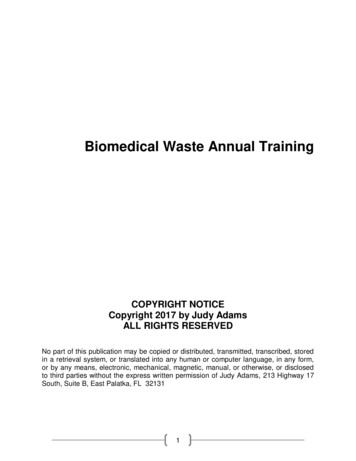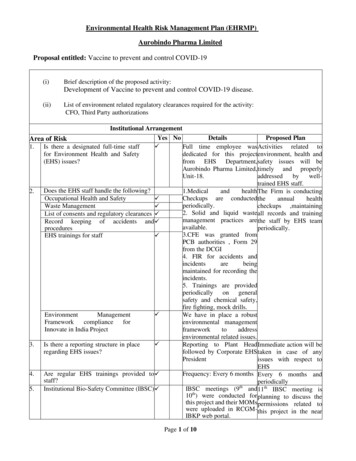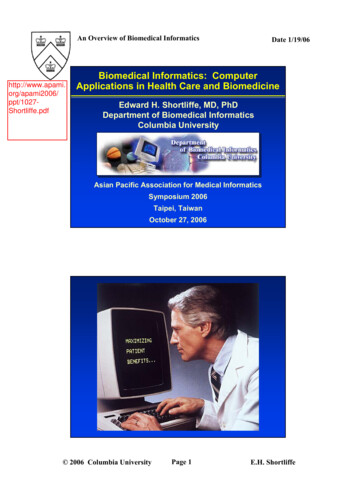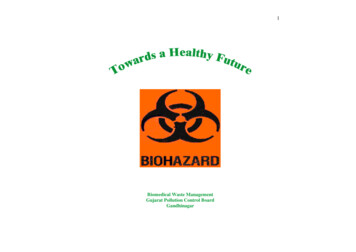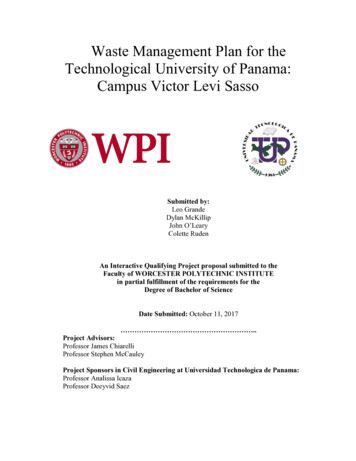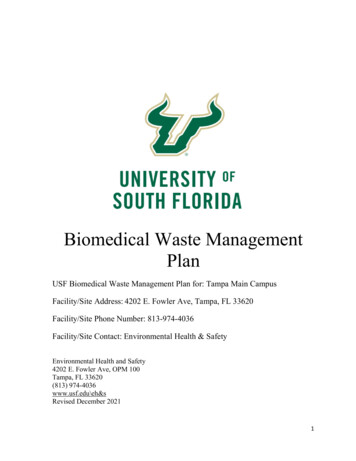
Transcription
Biomedical Waste ManagementPlanUSF Biomedical Waste Management Plan for: Tampa Main CampusFacility/Site Address: 4202 E. Fowler Ave, Tampa, FL 33620Facility/Site Phone Number: 813-974-4036Facility/Site Contact: Environmental Health & SafetyEnvironmental Health and Safety4202 E. Fowler Ave, OPM 100Tampa, FL 33620(813) 974-4036www.usf.edu\eh&sRevised December 20211
ContentsPOLICY . 3PURPOSE . 3RESPONSIBILITIES . 3DEFINITIONS. 3TRAINING . 4SEGREGATION . 5LABELING & PACKAGING. 5TRANSPORT . 5STORAGE & CONTAINMENT. 6SPILLS . 8EMERGENCY CONTINGENCY PLAN . 8PRE-TREATMENT METHODS . 8TREATMENT METHODS. 8PENALTIES . 92
POLICYBiomedical waste is generated by research, instructional, and clinical activities at the University of SouthFlorida (USF). The management of biomedical waste in the State of Florida is regulated by Chapter 64E16, Florida Administrative Code (F.A.C.) and in section 381.0098, Florida Statutes. All areas within USFthat generate biomedical waste are required to comply with the requirements of the USF BiomedicalWaste Management Plan. Departments may choose to implement a more stringent, site-specificBiomedical Waste Management Plan that serves their operational needs and must comply with at least theminimum set forth by the USF Biomedical Waste Management Plan.PURPOSEThe purpose of the Biomedical Waste Management Plan is to provide the requirements for the propermanagement of biomedical waste. Facility/Site specific information in this document is presented intabular format like in the following entry.USF Main Campus (Tampa)The Facility/Site name:RESPONSIBILITIESA. Environmental Health and Safety (EH&S) has the overall responsibility for the Biomedical WasteProgram, including the following tasks: Contract Management: Ensures that waste is picked up regularly in accordance with theFlorida Administrative Code (FAC) 64E-16. This also includes maintenance of shippingmanifests, invoices and other contract documents. Problem Resolution: Resolves problems between the University and vendors.Complaints or requests for special services should be directed to EH&S who in turncoordinates with the vendors. Inspection Coordination: Coordinates Department of Health biomedical wasteinspections and provides assistance to the Health inspector. Prepares corrective actionreports and forwards them to the Department of Health. Training: Offers training sessions to USF faculty, staff, and students and managesapplicable training records.B. Facility/Site Contacts are responsible for supervising biomedical waste practices in theirrespective areas. This includes: Ensuring that all applicable parties have received biomedical waste training prior tocommencement of duties related to biomedical waste and annually thereafter. Ensuring that all biomedical waste is handled and disposed of in accordance with therequirements of the USF Biomedical Waste Management Plan. Maintaining training documentation for all affected personnel. Contact EH&S forassistance in accessing digital training records.DEFINITIONS1. For the purposes of this document a “Facility” is permitted by FDOH and a “Site” is a subunit ofa Facility.3
2. Biomedical waste – Any solid or liquid waste which may present a threat of infection to humans,including nonliquid tissue, body parts, blood, blood products, and body fluids from humans andother primates; laboratory and veterinary wastes which contain human disease-causing agents;and discarded sharps. The following are also included:(a) Used, absorbent materials saturated with blood, blood products, body fluids, or excretions orsecretions contaminated with visible blood; and absorbent materials saturated with blood or bloodproducts that have dried.(b) Non-absorbent, disposable devices that have been contaminated with blood, body fluids or,secretions or excretions visibly contaminated with blood, but have not been treated by anapproved method3. Disinfection – the process of removing pathogenic microorganisms from objects or surfaces.4. Sterilization – the process used to destroy of all microorganisms on a surface or object, therebyrendering biomedical waste non-infectious.5. Cleaning – a process by which soap or detergent and water is applied to an area to remove dirtand organic matter from surfaces or objects. Cleaning may not kill microorganisms, but preparesthe object or surface for a more effective disinfection.6. Point of origin – the room or area where the biomedical waste is generated.7. Puncture resistant - able to withstand punctures from contained sharps during normal usage andhandling.8. Sharps - Any object capable of puncturing, lacerating, or otherwise penetrating the skin.This Facility/Site produces the following itemswhich are considered biomedical waste:SharpsLaboratory wastes which contain humandisease-causing agentsNonliquid tissue, body parts, blood, bloodproducts, and body fluids from humansTRAININGBiomedical waste training is required annually by paragraph 64E-16.003(2) (a), F.A.C. for all personnelthat handle biomedical waste. EH&S provides biomedical waste training through the EH&S BiomedicalWaste Training online, classroom-based, or via MS Teams. The main components of the training mustcover: Definition and identification of biomedical waste Segregation Storage Labeling Transport Spill Clean-up procedures Contingency Plan for Emergency Transport Procedure for containment Treatment methodEach Facility/Site must maintain records of employee training. Training records must be kept forparticipants in all training sessions for a minimum of three (3) years and must be available for review byDepartment of Health (DOH) inspectors. USF Environmental Health & Safety maintains digital recordsof training.4
Location of employee training records:Maintained by EH&S. Contact EH&S at813-974-4036.SEGREGATIONBiomedical waste must be separated from all other waste streams at the point of origin as per therequirements of 64E-16 of the Florida Administrative Code (FAC). Once separated, the waste must beplaced in either a sharps container or a red bag. Each individual location is required to have an adequatenumber of sharps containers and approved red bags to dispose of the biomedical waste generated.Mixed chemical and biomedical wasteBiomedical waste mixed with chemical waste, as defined in Chapter 62-730, F.A.C., must be managed ashazardous waste. Any biomedical waste that is mixed with chemical waste must be separated if possible.Any questions pertaining to mixed chemical and biological waste disposal should be directed to EH&S.Mixed radioactive and biomedical wasteBiomedical waste mixed with radioactive waste must be managed in accordance with the provisions ofChapter 64E-16, F.A.C. Any questions pertaining to mixed radioactive and biological waste should bedirected to Research Integrity and Compliance (RI&C).Broken glass must be discarded into a plastic-lined container with the label “Broken Glass” unless it iscontaminated with biological materials. Broken glass contaminated with biological materials must bediscarded in a red sharps disposal container.LABELING & PACKAGINGAll sealed biomedical red bags and sharps containers must be labeled with the following information: Facility/Site Name (e.g. USF) Facility/Site Address or department physical address Facility/Site Phone or department phone number Facility/Site Contact or responsible personIf a sealed red bag or sharps container is placed into a larger red bag prior to transport, labeling theexterior bag is sufficient. Outer containers are labeled by the biomedical waste transporter with theirname, address, registration number, and 24-hour phone number.TRANSPORTA transporter registered with Florida Department of Health removes biomedical waste from theFacility/Site. Storage of biomedical waste may not exceed 30 days (see also Storage & Containment).Pick-up times may vary by locations. The USF biomedical waste transporter and treatment facility is:Medigreen Waste Services.PO Box 403Goldenrod, FL 327335
Location of manifests of transport/transport log:Maintained on transporter website. ContactEH&S at 813-974-4036.STORAGE & CONTAINMENTBiomedical waste must not be stored for more than 30 days: after the first non-sharps item of biomedical waste is placed into a red bag, after the first non-sharps-item of biomedical waste is placed into a red sharps container, or after a red sharps container that contains only sharps is sealed.Access to indoor biomedical waste storage areas must be restricted through the use of locks, signs, orlocation. Locate away from pedestrian traffic and maintain in a sanitary condition. The area should beconstructed of smooth, easily cleanable materials that are impervious to liquids and vermin/insect free.Outdoor storage areas also must be conspicuously marked with a six-inch international biological hazardsymbol and must be secured from vandalism.These minimum containment standards must be followed according to Chapter 64E-16, F.A.C: Generators of biomedical waste shall purchase red bags from vendors who certify that their bagsmeet the applicable standards and maintain a copy of the certification on file in their department. Sharps containers shall meet the requirements of FAC 64E-16. Generators of biomedical wasteshall purchase sharps containers from vendors who meet the above standards. Place all contaminated sharps into red sharps containers at the point of origin. Non-infectiousneedles and needle-syringe units must be placed in sharps containers. Sharps containers must besealed and labeled prior to disposal by the biomedical waste transporter. Sharps shall be discarded at the point of origin into single use or reusable sharps containers.Needles and scalpel blades shall not be placed directly into double-walled corrugated containers.Sharps containers must be sealed when filled to the line indicated on the container. Sharps containers are considered full when materials placed into it reach the designated fill line,or, if a fill line is not indicated, when additional materials cannot be placed into the containerwithout cramming or when no additional materials are to be placed in the container. Red bags must be placed into an outer container at the point of origin prior to disposing of anybiomedical waste. The outer container must be rigid, leak-resistant and puncture-resistant.Reusable outer containers shall be constructed of smooth, easily cleanable materials and shall bedecontaminated after each use. Red bags must be sealed and labeled prior to disposal by thegenerator. Ruptured or leaking packages of biomedical waste must be placed into a larger container.Location of red bags:Location of sharps containers:Location of biomedical waste storage in theFacility/Site:See locations belowSee locations belowBioscience12020 USF(BSF)Cherry Drive,Tampa, FL33620Business3802Partners (BPB)Spectrum210Room 114,234Suite 210Room 3166
Blvd, Tampa,FL 33612Campus12301 USFRecreationMaple Drive,(REC)Tampa, FL33620Engineering Ill3824 USF(ENC)AlumniDrive,Tampa, FL33620FIT fitness13415 USFcenterLaurel Dr.,Tampa, FL33620Interdisciplinary 3720Research (IDRB) Spectrum107Blvd, Tampa,FL 33612Interdisciplinary 12030 USFScience (ISA)Cherry Dr,Tampa, FL336203010 USFMedical gy(PCD)Science Center(SCA)Shriners (SHR)WELL FitnessCenter 12901BBD Blvd Rm1201Drive12121 USFSweetgumLane ,Tampa, FL336203711 USFCitrus Drive,Tampa, FL3362012037 USFBeard Drive,Tampa, FL3362012502 USFPine Drive,Tampa, FL3362012901 BBDBlvd ,Tampa, FL33647Room 127Room 3001Room C103Rooms 107,121, 211,305, 313,424, 434,loading dockRooms 2007,3007, 4007,5007, 6007,7007Rm 1006Rooms 233,330Room 1203Freezer inroom 134,room 400left ofloadingdock, Room109Rm 12017
Storage is secured in the following manner: Locks, Signs, or LocationSPILLSSurfaces contaminated with spilled or leaked biomedical waste must be decontaminated with a solution ofindustrial strength detergent to remove visible soil before being disinfected: Cover the spill with a hypochlorite solution containing 100 parts per million (ppm) available freechlorine and leave for at least ten minutes (note: one part bleach plus nine parts water equals 100ppm). Employees cleaning spills of biomedical waste must wear appropriate personal protectiveequipment such as, but not limited to, gloves, gowns, laboratory coats, face shields or masks andeye protection. Spills should be reported to EH&S at 813-974-4036.Location of bleach:Location of PPE:See locations aboveSee locations aboveEMERGENCY CONTINGENCY PLANIf the primary transporter is unable to remove waste from the Facility/Site, another registered biomedicalwaste transporter will be selected from the Florida Department of Health’s Registered Biomedical WasteTransporter list.PRE-TREATMENT METHODSPre-treating infectious waste prior to disposal in the biomedical waste stream is recommended for BSL-2labs, but required for BSL-3 labs. The following pre-treatment methods are used at USF prior to ultimatedisposal: On-Site Steam Sterilization - autoclaves are used to reduce the infectious load of, or continuedgrowth of organisms in, potentially infectious biomedical waste by steam prior to biomedicalwaste being containerized for ultimate disposal through USF’s biomedical waste disposal vendor. Chemical Decontamination – a 10% bleach solution is primarily used for the decontamination ofliquid biomedical waste prior to disposal down the sanitary drain. This bleach solution can also beused decontaminate surfaces and objects contaminated with biomedical waste. It is also permittedto use EPA registered chemical germicides for chemical decontamination of biomedical waste.TREATMENT METHODSUSF does not treat biomedical waste except for minimal chemical decontamination of liquids/semi-solids,which are disposed to the sanitary sewer (liquids) or biomedical waste containers (semi-solids) forultimate disposal by USF’s biomedical waste disposal vendor. The USF biomedical waste disposalvendor uses the following treatment methods to decontaminate biomedical waste at off-site locations incompliance with 64E-16, FDEP, and FDOT regulations. Steam Sterilization – generally used for clinical waste and BSL-2 and lower waste. Incineration – generally used for BSL-3 agents, infectious animal waste, and carcasses.8
PENALTIESViolation of any provision of Chapter 64E-016, F.A.C., may result in denial, suspension or revocation ofthe university’s biomedical waste permits or an administrative fine of up to 2500 per day for eachviolation of this chapter or other enforcement action authorized by law.9
Biomedical waste training is required annually by paragraph 64E-16.003(2) (a), F.A.C. for all personnel that handle biomedical waste. EH&S provides biomedical waste training through the EH&S Biomedical Waste Training online, classroom -based, or via MS Teams. The main components of the training must cover:


